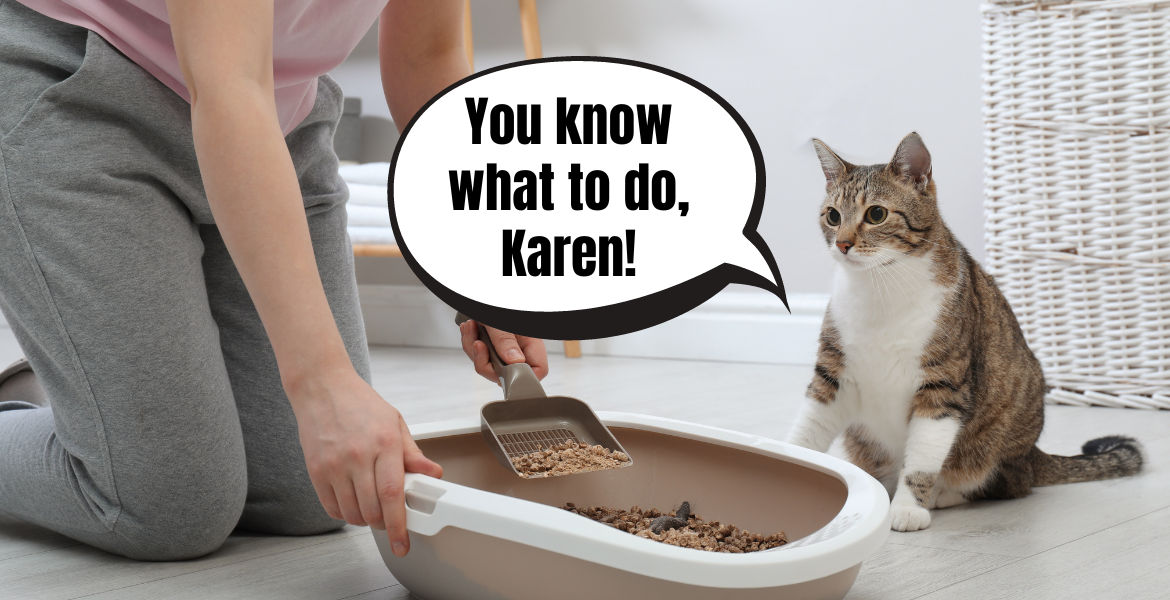Gleaming fur, clean paws, cleared sleeping spots, new scratching posts… all you need to be happy now is a sparkling and fragrant litter box. Because even though we bet, fabCats, that you clean your cats’ toilets very regularly, how often do you manage to clean them so that they look brand new and untouched? Be honest – we won’t judge!
Cleaning the litter box is, of course, the least enjoyable part of living with cats, but one thing is certain – every household member enjoys a clean litter box. So today, we’re asking a few important questions: How to care for the litter box beyond regular waste removal? How often should you change 100% of the litter and thoroughly clean the box? What chemical agents can be safely used to disinfect the cat’s toilet? Fasten your seatbelts, fabCats – we’re embarking on a journey into the depths of the litter box!
Litter Box Everyday Life – Cleaning the Litter Box from Scratch
Cleaning a cat’s litter box is easiest to compare to flushing a toilet – none of us would want the other household members to forget about it. However, cats aren’t eager to grab the scoop after each visit to the litter box and prefer to leave the cleaning to us. OK, we’ll take that on the chin. However, if you’re tempted, fabCat, to wait to remove the cat’s waste until there’s more accumulated in the litter box – we don’t recommend it.
Clean the cat’s litter box regularly, at least once a day,
and if you have more cats – even more often.
Why is this so important? Because accumulated waste in the litter box is not only a feast for bacteria and parasites, but also simply an unpleasant sight for both the cat and you, fabCat. Think about the smells emanating from there on hot, summer afternoons. Nothing pleasant! Don’t turn the litter box into a festival-worthy porta-potty if you wouldn’t want to use such a toilet yourself.
Dispose of all “surprises” scooped from the litter box in the trash. You can collect them in a separate, special bin for cat waste and dispose of them collectively, but never flush them down the toilet!
Although some cat litter is advertised as biodegradable and safe for toilets, flushing cat litter is legally prohibited in Poland and many other countries. For peace of mind, if you’re not sure what’s legal where you live, it’s better to simply dispose of cat waste in standard mixed waste bins.
Litter Replacement in the Litter Box: How Often is it Necessary?
Much depends on the type of litter you use, as each will behave differently when the cat uses the litter box. Generally, clumping litters can be changed less frequently – it’s easier to remove only the solidified material, leaving the rest of the litter in good condition. However, for hygiene purposes, try to do a complete litter replacement every 2-3 weeks (for clumping litters) and even once a week for other types of litter. This way, you can ensure that the litter box is always clean and fresh, without risking unpleasant odors coming from the litter box corner.
How much litter to pour? It depends on your and your cat’s preferences. We know cats who love to dig, and the more litter in the litter box, the more eager they are to use it, and those who prefer to feel solid ground under their paws. Between each full cycle of litter replacement, you can, of course, add a little bit more so that the cat always has something to dig in. However, don’t overdo it with the amount, just so you’re not tempted to prolong the next thorough litter box cleaning indefinitely.
Why does the litter box still smell after cleaning? Check out our blog:
Full Cleaning of the Litter Box – How, When, What to Use?
Let’s assume you use the classic, bentonite litter, and you thoroughly clean the litter box once every two weeks. What should you take care of when doing a full clean?
Get rid of all the litter. After two weeks of continuous waste removal, even if you do it thoroughly, the litter is no longer clean, and it should be completely replaced. Try to dose portions of litter between each cleaning cycle so that there is as little litter as possible in the litter box on the day of cleaning. Dump everything into one bag and into the mixed waste bin it goes.
Soak and wash the litter box thoroughly. Washing techniques vary. Hot water, a sponge, and some detergent will definitely come in handy – it can be soap, dishwashing liquid, or a cleaner specifically designed for cleaning litter boxes. We don’t recommend stronger agents (e.g., bleach), as they can damage the litter box surface, and their smell is too intense for a sensitive cat’s nose, even if everything is rinsed well.
Disinfecting the litter box. As befits a toilet, when thoroughly cleaning the litter box, it’s worth disinfecting it to eliminate any bacteria and microorganisms living on its surface. The simplest method? Pour boiling water over everything – it works quickly and ecologically. Steam cleaners work well here too (irreplaceable, among others, in the fight against Giardia), as do antibacterial products, which you leave on the surface for a few minutes to do their job. After everything, rinse and dry the litter box thoroughly, fill it with clean litter, and you’re done!
When to buy a new litter box?
One of the more beautiful aspects of spring cleaning is that sometimes we discover things that have long deserved to be replaced. But what should prompt you to consider it’s time for a new litter box?
- Scratches on the surface. Plastic litter boxes tend to develop scratches over time – whether from the scoop or the cat’s claws. Such scratches in plastic are a good breeding ground for bacteria, and although regular cleaning and sanitizing of the litter box do their job, heavy wear and tear on the material is a good signal that it’s time for a new one.
- Cracks. It’s probably obvious, but if your cat’s litter box is cracked, there’s no point in keeping it in the house by force. Broken plastic can injure the cat, not to mention the potential for urine leaking outside the litter box. Unpleasant situation!
- Inappropriate size. This is a common case when we buy a smaller litter box for a young kitten, and the little rascal outgrows it and doesn’t necessarily fit in it anymore. The cat should be able to turn around and move freely in the litter box – using it must be comfortable. So when the litter box is too small, don’t force the cat to “manage somehow” – turn it into an outdoor bowl, and get a proper, large cat toilet for indoors.
We hope, fabCats, that you accept the litter box cleaning challenge like true champions, and that your fur babies can boast the most well-maintained litter boxes in the neighborhood. If you have any questions or want to share your own tips and tricks for spring cleaning in the litter box – we’re waiting for you in the comments. In the meantime, we’re off to litter box excavations. Until next time!




